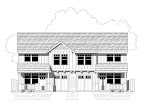What would life be without good old H-2-O? Dead, that's what. If a little water is good, more should be better, right? If you've been around the block even once you know that the standard answer to this formulaic question should be 'no'.
And of course it's no! Especially when we consider your house, your biggest investment, your protection from the elements, prying eyes, and the marauding huns. Why do builders let water pile up on a wood subfloor, leave their materials in the rain and mud, and install insulation and drywall over wet wood? How would they feel if their truck was built this way?
Building in the rain. In some parts of the country, this is a fact of life that is unavoidable. If it takes 3 months to frame a house, you are guaranteed a few rainy days. Since no one (not even weathermen) can accurately predict the weather beyond the next day, it is impossible to completely frame a house dry. Arizona, sure. Not in the Pacific Northwest though. But there are steps that can be taken to keep things as dry as possible. First, don't plan to build in January. Second, invest a few dollars in cheap insurance. If you are building an elevated wood floor (that is, a crawlspace not a slab), make your last step include a giant paint roller with a long handle and a discounted bucket of 5 gallon paint, color unimportant. This will protect your wood floor from standing water. Walls go up, roof goes up, and then sheathing as soon as possible. If there will be any amount of lag time getting the finish roof on, again paint the roof deck. The problem here is that there are always spaces between roofing panels and water will leak through. The worst spot is the peak, especially if a ridge vent is planned. This gives a beautiful 6" wide by 20' long space for rain to come right in. If you have a butterfly roof, don't build in the rain as this would make a funnel.
Finally, I don't care how tight your schedule is, buy a $13 moisture meter from Harbor Freight and don't do anything else until the moisture content is below 19%. Since the aforementioned tool has an accuracy rating of +/-2% for wood, go for 17%. Why 19%? Most mold and fungus will not thrive below that and most insects will move out. It wall also allow better equilibrium in the wood resulting in less drywall cracks and creaking of the home. Further, it will reduce the amount of moisture trapped in the walls. Even further, some codes require this.
Storing your materials. Too often we go to construction sites and see a pile of 2x6 sticks sitting in the mud getting rained on. Double you tee eff. How is this okay? What part of this makes you feel good? If you were a pig or a toad, maybe, Spend a few bucks for some pallets to keep your wood off the ground, then get some tarps or used billboard vinyls. "Why would I spend hundreds on this?" Hundreds? No, less than that. Did you even click the link? A 10'x30' used vinyl is $60. And you spend less than a hundred on this to get your moisture content down and save thousands on a callback. Please don't be that short-sighted.
Think of it this way; the less moisture the wood takes into the house, the less time you need to wait for it to dry out.
Protecting your product. Your product is the house and it's only worth the amount of trouble free time it will stand. If moisture gets into the wall, the value ends. Your goal is to manage the moisture that gets into the wall. Not to keep moisture out of the wall, but to manage it. It will get in. From the outside. Unless you are installing double welded steel siding, wind and thermal will drive moisture behind the siding. At this point you have two options. The first is to pretend it doesn't happen. The second is to manage it.
So you've decided to manage your water issue. The first step is admitting you have a problem so you're already on the way. The second step is called a rainscreen. There are several off the shelf products that can achieve this concept. You can also use scrap plywood on site to create 2-3" battens and manage the water. The idea is that the water that gets behind the wall then drains in a wide enough plane to not get stuck via capillary action and then drain out a screen at a bottom. Water that freely drains is no longer available to stick around via surface tension and find crevices and cracks in your construction and seep into the wall. Water in the wall can wet insulation, rendering it useless. It can also harbor mold, mildew, and insects, hazarding your house and it's occupants' health. If you have any lick and stick fake stone veneer, this is tantamount as the stuff is like a sponge. It will readily take in water and hold it. When the sun comes out, it will be driven back and then be held against your sheathing or building paper. Compounds in the mortar then eat away at the paper and the moisture is free to roam about your wood sheathing.
Getting it right. Contact Istockhouseplans for CAD details about how to handle this moisture. We can spec out a rainscreen for you and make sure your final product is the best possible.
Tuesday, November 16, 2010
Subscribe to:
Post Comments (Atom)






No comments:
Post a Comment